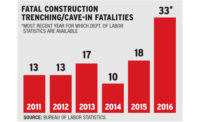In the wake of a recent rise in fatal trenching cave-ins, the federal Occupational Safety and Health Administration has begun a targeted education and enforcement program to try to reverse the trend.
The program, which began on Oct. 1, is an update of its 1985 National Emphasis Program on trenching safety and responds to what the agency calls “a recent spike” in such accidents.
Loren Sweatt, deputy assistant labor secretary for occupational safety and health, said in an Oct. 2 statement, “OSHA will concentrate the full force of enforcement and compliance assistance resources to help ensure that employers are addressing these serious hazards.”
According to the Bureau of Labor Statistics, the number of construction trenching cave-in deaths jumped to 33 in 2016, from 18 in 2015 and 10 in 2014.
In an Oct. 1 directive to its staff, OSHA notes that there were 104 trenching-related construction fatalities over the 2011-2016 period. It added, “An alarming 49% of those construction fatalities occurred between 2015 and 2016.”
Those are the most recent Labor Dept. figures available.
For 2017, there were at least 21 construction-related trenching deaths, according to unofficial data compiled by the union-affiliated CPWR-the Center for Construction Research and Training. [View CPWR interactive map here.]
Those numbers may not be precisely comparable with the BLS figures. The bureau is expected to release its fatal-injury statistics for 2017 in December.
Looking at 2018, there have been several more fatal trenching accidents since June, according to Jordan Barab, a former senior OSHA official during the Obama administration.
In an Oct. 3 post on his blog, Confined Space, Barab lists seven trenching fatalities in six accidents from June through September, based on media reports.
OSHA’s new trenching-safety program begins with three months of outreach. The agency’s area offices and regions will be required to provide compliance-assistance information to companies, construction companies, trade associations, nonfederal permitting agencies and others
The agency says that enforcement work will start after the three-month outreach period “and remain in effect until canceled.”
Reactions from Contractors, Labor
Kevin Cannon, Associated General Contractors of America senior director for safety, likes the OSHA program. “I think it’s a balanced approach,” he said in an interview.
Cannon says that the combination of enforcing the laws and OSHA safety standards and helping companies understand their compliance obligations could be effective in addressing the trench fatality problem.
North America’s Building Trades Unions support OSHA’s trenching and excavation emphasis program, says Chris Trahan Cain, director of safety. “The update is good as well as the instruction to the field [staff] to really ramp up the outreach on this issue,” Cain said in an email.
She adds, “I hope employers pay attention and work to ensure that no workers are put in harm’s way, given the hazard is so common and how to safeguard workers’ lives are so well understood.”
Cain isn’t concerned about waiting for three months to start the updated program’s enforcement phase. She notes, “OSHA has [the 1985 program] in place and can essentially inspect any hazardous trench it sees during the outreach time frame.”
But Cain also says, “While I don’t think it is harmful to do a pre-enforcement outreach effort in this case, I don’t think it should be the norm if OSHA needs to implement new enforcement policies in general.”
Stephen M. Wiltshire, Associated Builders and Contractors director of safety, said via email, "World-class safety should be expected and implemented on all construction jobsites, but especially when conditions include hazards like a trench or excavation."
Wiltshire adds, "We applaud OSHA's education and outreach efforts to update the National Emphasis Program on preventing trenching and excavation collapses to better ensure construction workers at these jobsites are safe, secure and protected."
In its Oct. 1 memo, OSHA directs its compliance safety and health officers to do an inspection “whenever they observe an open trench or an open excavation regardless of whether or not a violation is readily observed.”
The directive adds, “These observations may occur during the course of their normal workday travel or while engaged in programmed or un-programmed inspections.”
In addition, the OSHA notice says that states that have OSHA-approved plans must tell the federal agency within 60 days whether they will adopt trench safety policies that are the same as the federal ones.
Barab gives credit to OSHA for the new program, but he would like to see the agency go further. Among other things, Barab recommends that the agency should refer all willful trench cases to the Dept. of Justice for criminal prosecution and calls for state and local governments to require permits for anyone seeking to do trenching.
Safety grants awarded
On a related front, Barab points out that OSHA’s 2018 round of Susan Harwood safety and health grants, awarded on Oct. 1, include two focused on excavation: $150,000 to the State Building and Construction Trades Council of California to provide “train the trainer” programs and $75,000 to Purdue University to produce safety materials for construction companies and workers.
In addition, a $92,000 Harwood grant to the Sitka-based Alaska Native Tribal Health Consortium for general construction training includes excavation hazards as one of the topics. A nearly $165,000 grant to the Latino Worker Safety Center in Hillside, Ill., covers training for a construction and several other industries.




